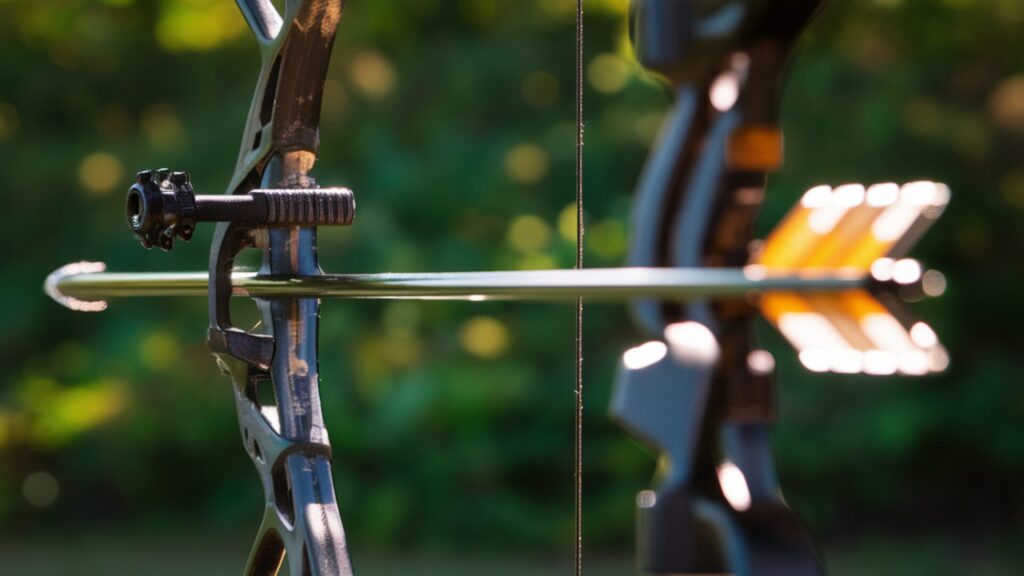A compound bow is a modern bow that uses a levering system of cables and pulleys to bend the limbs, making it easier to draw and hold at full draw. The compound bow was first developed in the 1960s by Holless Wilbur Allen, who was looking for a more efficient way to hunt. Compared to traditional bows, compound bows offer several advantages, including increased accuracy, power, and speed.
Recommended Best Compound Bow in 2024-2025
| Recommendation | Product |
| Best Overall | Diamond Archery Edge 320 |
| Popular Choice | Bear Archery Cruzer G2 Compound Bow |
| Best Value | PSE ARCHERY D3 Bowfishing Compound Bow |
| Best Budget | Predator Archery Raptor Compound Bow |
| Another Excellent Pick | Sanlida ragon 10 Hunting Compound Bow |
Construction of a Compound Bow
A compound bow is made up of several parts, including:
- The riser: The central part of the bow where the limbs attach.
- The limbs: The flexible parts of the bow that store and release energy when the bow is fired.
- The cam or cams: The pulley system that reduces the amount of force needed to draw the bowstring back.
- The bowstring: The string that connects the two ends of the bow and propels the arrow forward when released.
- The cables: The cables that run from the cam to the opposite limb, helping to reduce the amount of force required to hold the bow at full draw.
- The arrow rest: A device that holds the arrow in place before and during the shot.
- The bow sight: A device that helps the archer aim accurately.
- The stabilizer: A weight or weights that help to balance the bow and reduce vibration during the shot.
- The quiver: A device for holding arrows.
Advantages of a Compound Bow
One of the main advantages of a compound bow is that it requires less physical strength to draw and hold at full draw than a traditional bow. This is because the pulley system reduces the amount of force needed to draw the bowstring back, and the let-off feature allows the archer to hold the bow at full draw with much less effort. This makes it easier for archers to aim and shoot accurately, especially over longer distances.
Another advantage of a compound bow is that it can be customized with accessories such as a bow sight, stabilizer, and arrow rest to improve accuracy and consistency. Compound bows also tend to be more powerful and faster than traditional bows, which can be important for hunting and competitive shooting.
Compound Bow vs. Traditional Bow
While traditional bows such as recurve and longbows have a simpler design and are often favored by traditionalists, compound bows have several advantages over them. Traditional bows require more physical strength to draw and hold at full draw, making them less forgiving and more challenging to shoot accurately. They also tend to be less powerful and slower than compound bows, which can be a disadvantage in some situations.
However, traditional bows have a timeless appeal and require more skill and practice to master. They are often used in traditional archery and historical reenactments, and many archers enjoy the challenge of shooting them.
Choosing a Compound Bow
When choosing a compound bow, there are several factors to consider, including:
- Draw weight: The amount of force required to draw the bowstring back.
- Draw length: The distance between the bowstring and the grip when the bow is at full draw.
- Axle-to-axle length: The distance between the two cams or wheels on the bow.
- Brace height: The distance between the bowstring and the grip when the bow is at rest.
- Let-off: The amount of weight reduction that occurs once the bow is at full draw.
- Bow weight: The weight of the bow itself.
It’s also important to consider your intended use for the bow, whether it’s hunting, competitive shooting, or recreational target shooting. Different bows may be better suited for different purposes, so it’s important to do your research and choose a bow that meets your specific needs and preferences.
Maintaining a Compound Bow
Like any piece of equipment, a compound bow requires regular maintenance to ensure it performs at its best. This includes keeping the bow clean and dry, inspecting the bowstring and cables for wear and damage, and periodically replacing worn or damaged parts. It’s also important to store the bow properly when not in use and to use a bow case to protect it during transport.
With proper care and maintenance, a compound bow can last for many years and provide countless hours of enjoyment and satisfaction.

Frequently Asked Questions
What Is The Difference Between A Compound Bow And A Regular Bow?
A compound bow uses a pulley system for bending the limbs, providing greater accuracy and power. Recurve bows have a simpler design without this pulley system.
What Is The Purpose Of A Compound Bow?
A compound bow is designed for accuracy and power in archery, utilizing a pulley system for efficient limb bending.
Which Is Better, A Recurve Or A Compound Bow?
A compound bow is better for beginners due to its adjustability and ease of use. It offers longer-lasting potential and growth for the archer. However, a recurve bow has a simpler design and offers unmatched simplicity.
How Is A Compound Bow Different From A Simple Bow?
A compound bow differs from a simple bow due to its complex pulley system and let-off feature, providing more accuracy and power at a greater distance. It requires less physical strength and offers easier adjustability, making it advantageous for many archers.
Conclusion
A compound bow is a modern bow that uses a pulley system to reduce the amount of force required to draw and hold the bowstring at full draw. Compared to traditional bows, compound bows offer several advantages, including increased accuracy, power, and speed. When choosing a compound bow, it’s important to consider factors such as draw weight, draw length, and intended use. With proper care and maintenance, a compound bow can provide years of enjoyment and satisfaction for archers of all skill levels.








